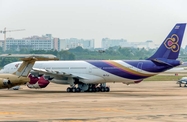Having bounced back from a lean period in 2008-09, when its main airport was shut by protests and overseas visitor numbers fell following the onset of the global economic downturn, Thailand’s aviation industry is now looking to expand its ground facilities and fleet size.
According to Airports of Thailand, which operates the country’s main aviation facilities, there was a 7.3% increase in passenger movements through the six major airports in the half-year up to March 2011. International traffic rose by 10.2% year-on-year to 21.66m passengers, while there was a more modest 2.6% gain for domestic travel, with local passenger numbers hitting 12.47m.
It was not just a matter of more seats being sold, with the number of international flights climbing by 12.4% to 123,814 and domestic flights up to 96,250, an increase of 8.3%. Bangkok’s Suvarnabhumi Airport remained the busiest, handling 72% of passengers and 66% of all flights, including 19m international passengers and 105,000 overseas flights.
Though the figures for overseas travel are strong, they have yet to factor in the full impact of the Japanese earthquake and tsunami of March 11 and the subsequent downturn in travel to and from Japan. National carrier Thai Airways International (THAI) was hit hard by the twin disasters, with the airline forecasting severely reduced traffic and turnover into the second half of the year in what is its largest single market. “The crisis in Japan will affect the company’s revenues. The impact is expected to continue on the airline for three to four months,” THAI’s president, Piyasvasti Amranand, said on April 21.
In the wake of the natural disaster, state-owned THAI reduced flights to Japan as bookings fell, with landings declining from 59 a week to 52. Despite this, the cabin factor – the percentage of seats sold – on flights to Japan dropped below 50%, from the usual 70-80%. Piyasvasti told the media he expects the disaster to lead to a loss of $20m in monthly revenue. Though less affected, other Thai carriers have also seen numbers fall since mid-March, as the overall flow of Japanese travellers across Asia has dwindled.
Figures compiled by the International Air Transport Association show that just under 1m arrivals from Japan flew into Thailand last year, while total traffic on the Thailand-Japan route came to 2.3m passengers, representing 15% of Thailand’s international air travel revenue. A prolonged downturn in the Japanese market will have a major impact on Thai carriers, which earned $1.16bn from connections to Japan in 2010.
At the same time that THAI is dealing with losses on its most profitable routes it has embarked on the process of renewing its ageing fleet. Some of THAI’s planes have up to 20 years of service behind them, meaning the fleet is less competitive than those of some of its rivals in terms of carrying capacity, while the its aircraft can also require longer periods of down time for regular maintenance.
The airline is looking to replace many of its older aircraft using the $15.3bn allocated for fleet improvement. It will expand its fleet from the present 85 aircraft to 107, bringing the average age of its planes down from 11.7 years to 8.5. This will be achieved by adding at least 37 planes to by 2017 and up to 75 by 2023, with a number of older planes being taken out of service in the process.
While the airline has decided how many planes it wants, and what types – with 26 wide-bodied and 11 narrow-bodied aircraft on its shopping list – THAI has not yet placed orders for all of these. It has booked delivery of seven Airbus and eight Boeing aircraft on a long-term lease/purchase deal, but THAI has yet to decide whether to go for an outright purchase or a leasing agreement for the balance of its needs.
The expectation is that the carrier will go for a mix of leasing and direct buying, which could allow it to tailor its long-term capital spending programme to suit its short- and medium-term cash flow and credit arrangements.
Of course, that cash flow is dependent on a number of factors, some of which, such as natural disasters in the region, are well out of the airline’s control. While the long-term appeal of the country is not in doubt, any resurgence of political unrest – such as that which occurred in 2010 and could resurface ahead of the general election to be held this year – could lead to a fall in passenger numbers. However, past events have shown that Thailand’s tourism industry has strong recuperative powers.

